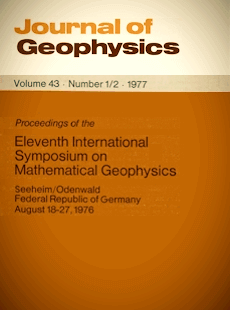Finite-difference modelling for P-pulse propagation in elastic media with arbitrary polygonal surface
Article Sidebar

Vols. 1-18 (1924-1944), ISSN 0044-2801
Main Article Content
Abstract
The applicability of the finite-difference methods has been limited in most cases to simple geometric shapes. The problem of introducing boundary conditions into the scheme has usually restricted the models to structures in which the boundaries are parallel to the coordinates. Recently, several investigators have studied the effect of prominent topographic features on seismic signals. Most deal with SH waves. The behaviour of a P-SV pulse in media with prominent irregular surfaces is yet almost unknown. The difficulty of the last problem relative to the SH case lies in the vectorial form of the equation of motion and the more complicated boundary conditions. In the present work a technique is proposed for simulating the P-SV wave propagation in a two-dimensional half-space with an arbitrary polygonlike topography. This technique has been applied to compute seismograms due to a P-pulse on surfaces of ridges and canyons. The incident pulse is amplified at the crest of mountains and at the upper corners of canyons. The magnitude of amplification is a function of the steepness of the topographic structure and can increase by 50 % compared to a flat surface under the same conditions. The maximum attenuation computed at the bottom of a canyon was 25 %. It can be concluded that the influence of prominent topographic features on the incident P-pulse is similar to that on incident SH waves, which was computed in previous investigations.
 ARK: https://n2t.net/ark:/88439/y066050
ARK: https://n2t.net/ark:/88439/y066050
Permalink: https://geophysicsjournal.com/article/279
Article Details
References
Alterman, Z.S., Loewenthal, D. (1970) Seismic waves in a quarter and three quarter plane. Geophys. J. 20:101-126
Alterman, Z.S., Nathaniel, R. (1975) Seismic waves in a wedge. Bull. Seism. Soc. Am. 65:1697-1719
Boore, D.M. (1972a) Finite-difference methods for seismic-wave propagation in heterogeneous materials. In: Methods in Computational Physics, Vol. 11, Chapter 5. Academic Press, New York
Boore, D.M. (1972b) A note on the effect of simple topography on seismic SH waves. Bull. Seism. Soc. Am. 62, pp. 275-284
Boore, D.M. (1973) The effect of simple topography on seismic waves. Implications for the accelerations recorded at Pacoima Dam, San Fernando Valley, California. Bull. Seism. Soc. Am. 63:1603-1609
Bouchon, M. (1973) Effect of topography on surface motion. Bull. Seism. Soc. Am. 63:615-632
Browning, G., Kreiss, H.O., Oliger, J. (1973) Mesh Refinement. Math. Comp. 27:29-39
Davis, L.L., West, L.R. (1973) Observed effects of topography on ground motion. Bull. Seism. Soc. Am. 63:283-298
Ilan, A., Ungar, A., Alterman, Z. (1975) An improved representation of boundary conditions in finitedifference schemes for seismological problems. Geophys. J. 43:727-746
Ilan, A., Loewenthal, D. (1976) Instability of finite-difference schemes due to boundary conditions in elastic media. Geophysical Prospecting 24:431-453
Reimer, R.B., Clough, R.W., Raphael, J.M. (1974) Seismic response of Pacoima Dam in San Fernando Earthquake. Proc. World Conf. Earthquake Eng. 5th, Rome 2, pp. 2328-2337
Richtmyer, R.D., Morton, K.W. (1967) Difference methods for initial value problems. Interscience, New York-LondonSydney
Trifunac, M.D. (1973) Scattering of plane SH waves by a semicylindrical canyon. Intern. J. Earthquake Eng. Struct. Dyn. 1:267-281
Trifunac, M.D., Hudson, D.E. (1971) Analysis of the Pacoima Dam accelerogram, San Fernando. California, earthquake of 1971. Bull. Seism. Soc. Am. 61:1393-1411
Wong, H.L., Jennings, P.C. (1975) Effects of canyon topography on strong ground motion. Bull. Seism. Soc. Am. 65, 5, pp.1239-1257
Wong, H.L., Trifunac, M.D. (1974) Scattering of plane SH waves by semielliptical canyon. Intern. J. Earthquake Eng. Struct. Dyn. V. 3:157-169











